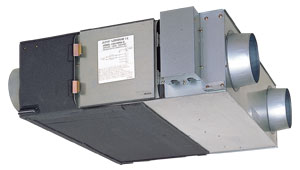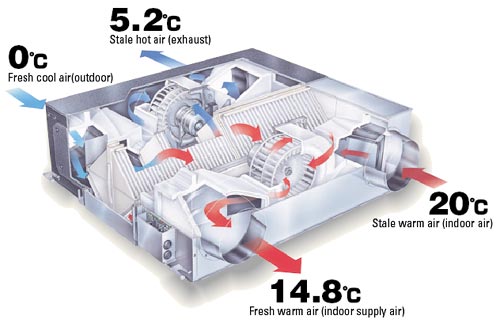Lossnay Fresh Air (Energy Recovery Systems)
LGH-15RX5-E
In-ceiling Lossnay unit. Air volume: 42 l/s. (WxDxH, mm): 780 x 610 x 275. Weight: 17kg. The PZ-60DR-E remote controller is required.

In-ceiling Lossnay unit. Air volume: 42 l/s. (WxDxH, mm): 780 x 610 x 275. Weight: 17kg. The PZ-60DR-E remote controller is required.

Poor air quality can be attributed to many problems arising in the workplace or in the home. It is believed to contribute to a significant loss in productivity, low morale and higher rates of sickness among many employees. The object of providing good ventilation alongside air condition in residential and commercial buildings is to provide conditions under which people can live and work comfort and safety.
Developed and refined over the past 30 years, the LOSSNAY system has perfected the recovery of waste energy. The units reduce overall energy costs by extracting stale air and then recovering the heating or cooling energy to either warm and cool incoming fresh air. By utilising this energy, the LOSSNAY system can save up to 30% on initial capital costs of heating and cooling plant.
Every building needs a supply of fresh air to keep its inhabitants healthy and comfortable. Outdoor air though is rarely, if ever, the same temperature as that maintained by the building's air conditioning system. In the summer, it is too hot. In the winter, it is too cold. This puts added stress on the air conditioner to compensate for the intake of the hot or cold air adding to the expense of operating the system. LOSSNAY all but eliminates this problem with original energy-recovery technology that uses the heat of the stale indoor air to be expelled in order to either heat or cool the incoming fresh air to a temperature much closer to the existing indoor air. This process reduces the load on the air conditioning system without cutting off the supply of vitally necessary fresh air.
The remarkable technology that permits the intake of fresh air with minimal loss to indoor temperature is know as the LOSSNAY Core. The cross-flow, plate-fin structure of the energy-recovery unit along with a specially processed diaphragm keep supply and exhaust air separate, ensuring that only fresh air is introduced to the indoor environment while also allowing for the efficient transfer of heat.
The microscopically small pores of the diaphragm have been made even smaller, decreasing the rate at which water soluble gases such as ammonia and hydrogen pass through. Further, a new specially processed paper used to make the diaphragm has been developed with high moisture permeability characteristics that aid in the transference of moisture for improved energy exchange efficiency. These developments further improve moisture permeability and effectiveness in shielding unwanted gases, resulting in a lower rate of gas transference and more highly efficient energy transfer.
The secret to the unmatched comfort provided by Lossnay core is the cross-flow, plate-fin structure of the heat-exchange unit. A diaphragm made of a specially processed paper fully separates inducted and exhausted air supplies, ensuring that only fresh air is introduced to the indoor environment.
The superior heat-transfer and moisture permeability of the special paper assure highly effective total heat exchange (temperature and humidity) when inducted and exhausted air supplies cross in the Lossnay core.
Air volume level can be set hourly (max 8 times) and weekly. You can pre-set air volume according to the predictable requirement so that Lossnay can automatically operate at only necessary air-speed at the specified time period, which saves power consumption while maintaining the indoor air quality. Besides, once the weekly timer has been set, no switching on – off is required.

In addition to the conventional Extra High, High, and Low modes, an Extra Low* mode is added to provide a more dynamic range of air volume settings and versatility in a variety of installation environments, yielding much better energy conservation. Using a simplified timer function, it switches to Extra Low operation when the operation stop button is activated and it is accordingly possible to implement 24-hour energy conservation ventilation.
* Extra-Low mode not included in the LGH-150RX5 and 200RX5 units.
In addition to the automatic damper open/close function, open/close control via external devices is now possible, delivering a “By-pass” ventilation system that is suitable to the installed environment.

Automatic ventilation setting
The automatic damper mode automatically provides the correct ventilation for the conditions in the room. The
following shows the effect “By-pass” ventilation will have under various conditions.
* When the outdoor air tempereture drops lower than 8°C it changes to the heat
exchange ventilation. (Display of the remote controller does not change.)
* In the case of “By-pass” ventilation, the supply air temperature slightly rises more
than the outside air temperature because of the heat effect around the ducts or the unit motors